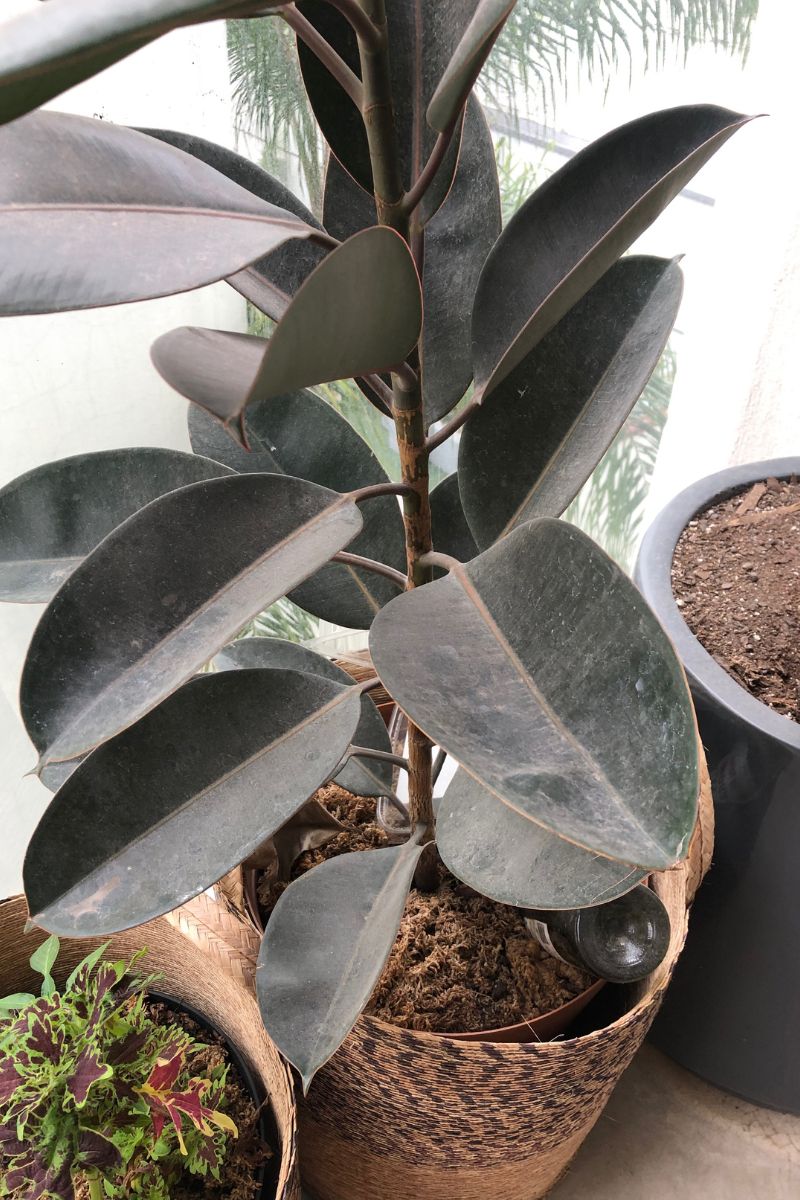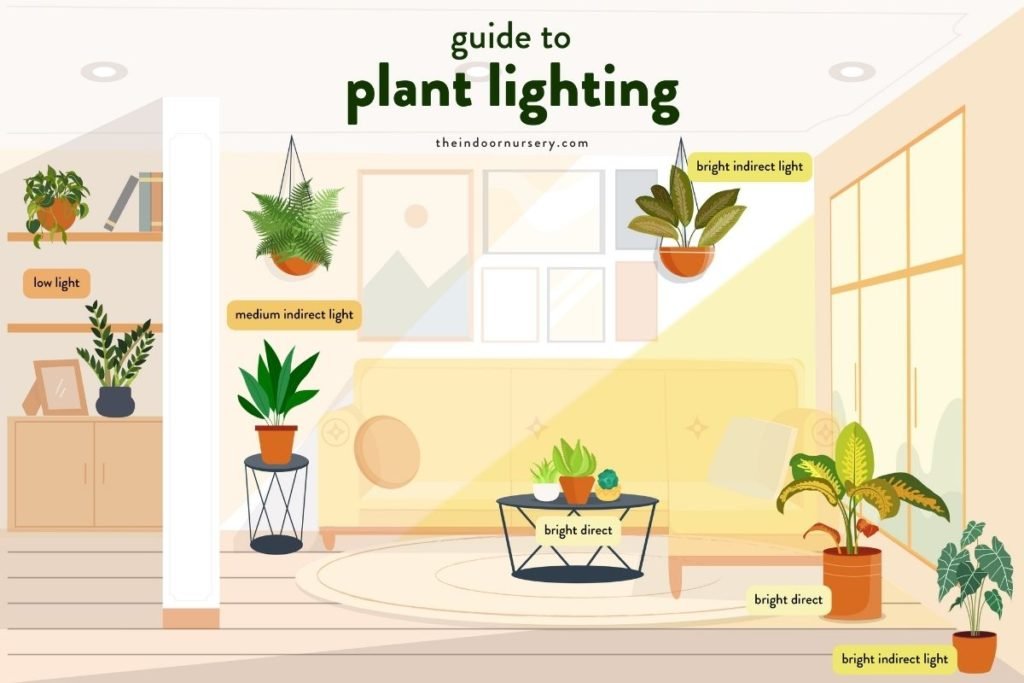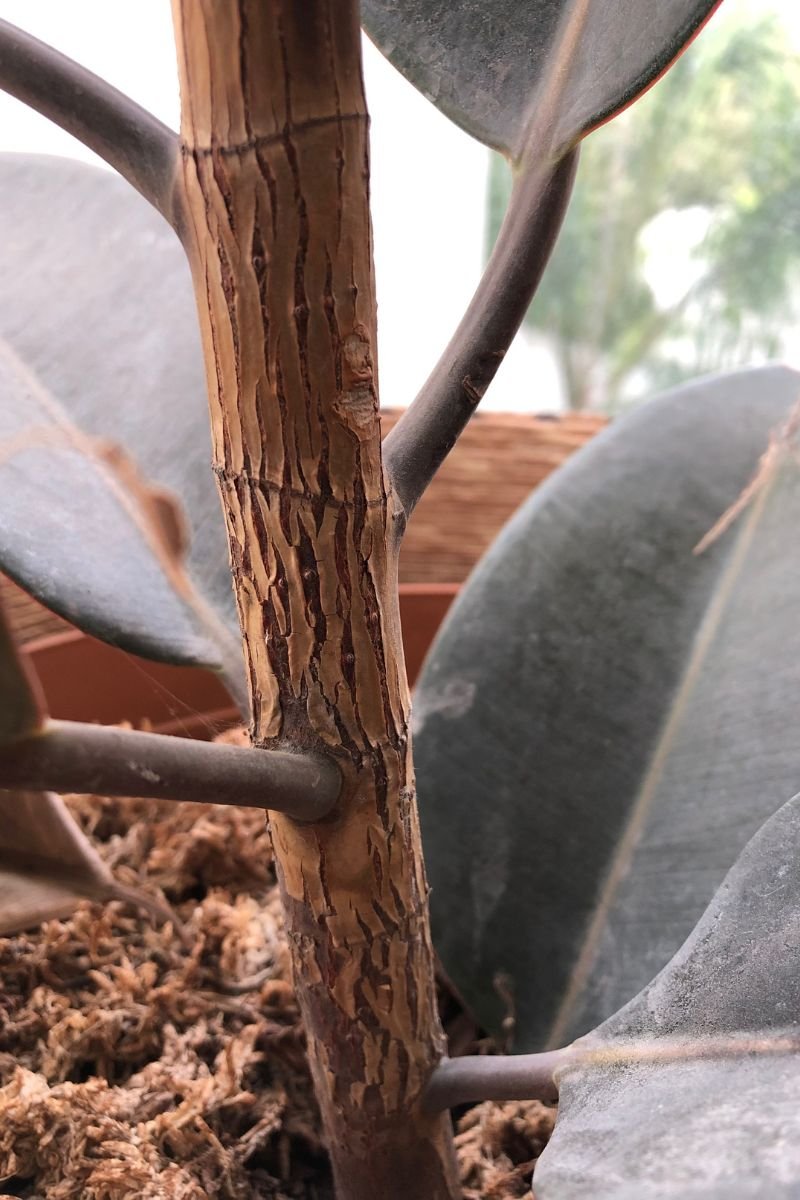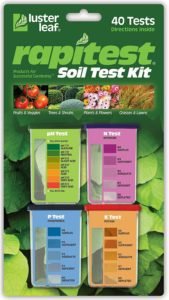A rubber plant (ficus elastica) is one of those plants that just looks sturdy, with a bushy set of big, waxy leaves, and a woody center stem.
In nature, a rubber plant matures into a canopy-level tree, growing over a hundred feet tall. When we keep it indoors as a potted plant, however, it won’t be able to stretch its roots widely enough to get so big, but they can still grow many feet tall as a house plant.
The large, flat leaves are a source of color in a room, whether it’s a deep green or a variegated variety with light green or white splashes on each leaf. If these leaves start curling and looking lifeless, it’s likely due to environmental conditions like too low of humidity, overwatering, underwatering, or one of a few other problems that can stress a rubber plant.
Which is exactly what got me down this rabbit hole. Living in Mexico has been rough for my houseplants on account of the dry, sun-drenched weather. Soil dries out faster than I can pour water and a thick layer of pollution dust covers the leaves within 5 days.
It’s hard to keep up and my plants suffer. Here’s what I learned in the process of fixing up my rubber plant.
Why rubber plant leaves curl
There are multiple reasons why a rubber plant’s leaves may curl upwards or downwards, having to do with moisture, light, and stress from other sources. Here, we’ll go over:
- Underwatering
- Overwatering
- Low Humidity And Cool Temperatures
- Low Light
- Direct Sunlight
- Fertilizer Stress
- Pest Stress
- Growing New Leaves
Underwatering
One of the main causes of curling leaves is dehydration. When a rubber plant doesn’t get enough water, the leaves have to tap into the moisture stored in the stems and leaves. Leaf curl happens when the tissue contracts to decrease the surface area and be more efficient with the remaining internal moisture. A rubber plant needs to be watered every week or two, based on how big the plant and its pot are. A small plant pot will dry out more quickly than a large one, so smaller plants are more at risk of dehydration, while they also store less moisture internally than larger plants can.
If your rubber plant’s leaves are thin and curled, but plump back up after a watering, it’s a sign they should probably be watered more frequently. The plant may need to be upgraded to a bigger pot so the soil can hold more water, longer. In general, it’s best to water your plant before it has to tap internal reserves.
Overwatering
While underwatering can make leaves curl from dehydration, overwatering can cause a plant’s leaves to curl from root damage. When a rubber plant’s pot has excess water, roots can’t get enough air, oxygen, or nutrients to deliver to the rest of the plant. In nature, a ficus elastica grows with the upper levels of its root system above the ground, and rubber trees grown indoors similarly prefer their roots to be well-aerated. Potting soil that drains well in a pot that has drainage holes is important to keep your rubber plant’s root system in its most comfortable conditions.
Using a water meter is the best way to avoid improper watering if you aren’t sure exactly what sort of a schedule to keep. Every one or two weeks should be right for a rubber plant in spring and summer when the plant is growing most quickly, but less frequently during the fall and winter when growth slows down.
A moisture meter should read 3 or 4 for a rubber plant at the center of the pot, with the upper couple of inches of soil having dried out. In addition to curling leaves, yellowing, browning, drooping, and wilting are signs your plant may be suffering from root rot, which can take hold of the roots if they sit in excess water for too long.
Low humidity and cool temperatures
As a tropical plant from Southeast Asian rainforests, a ficus elastica is used to a fair amount of humidity. While it does receive much of its moisture through its roots, some water vapor is absorbed through the leave’s pores.

Humidity also helps prevent the plant from losing moisture: when the humidity level is kept between 50% and 80%, there is enough moisture in the air that the leaves won’t suffer from forced transpiration, when moisture is pulled from a leaf by the dry air.
If you’re in a particularly dry area, then a plant humidifier can be a great help.
Rubber plants are particularly sensitive to cool air as well, since in the tropics, they’re used to warm temperatures year-round. A drafty breeze from a door, window, or air conditioning unit can result in curled, yellowed, or brown leaves as they lose moisture and dry out.
Low light
Your rubber plant loves lots of bright, indirect light to keep its chlorophyll production going. Variegated varieties may like a little less light than fully green ones, but in both cases, too little light will result in too little chlorophyll production. This can cause leaves to curl and droop from low energy. If you have a curling rubber plant and the soil seems to be the right moisture level, consider whether the room is too dark for your plant. You should be able to comfortably read a book in the light. Even though a ficus elastica can tolerate some shade, it may need to be moved if its location is too dark for the leaves to remain firm and photosynthetically productive.
Direct sunlight
In the wild, a rubber plant will grow in the shady understory until it reaches its mature height of one hundred feet or more. Since our indoor plants will remain between bush and sapling size, their leaves should be kept out of direct sunlight. Variegated varieties of rubber plants are even more sensitive to too much light than their green relatives. If you’re noticing a rubber plant’s leaves are curling up, yellowing, and/or developing crispy brown edges, assess the location: are they in or near a window that gets direct sunlight in the morning or afternoon? If so, move it to a spot where it won’t receive such harsh light.

Read more: Our plant light guide shows you exactly where to place your indoor plants.
Fertilizer stress
Ficus elastica is used to a nutrient-dense rainforest floor, where it receives a regular supply of refreshed nutrients year-round. Indoor plants need fertilizer to replenish nutrients that the plant uses up, and rubber plants are no different. They’ll become stressed when they don’t receive enough nutrients, and may start to look droopy and wilted. Applying a serving of rubber plant fertilizer once every month, or once every two weeks with a half or quarter dose, will keep your plant nourished and perky.
Overfertilizing, however, can stress out the plant as well. Too much synthetic fertilizer, which is usually salt based, can damage the plant’s roots, known as a fertilizer burn. Damaged roots can’t absorb nutrients, oxygen, or moisture, which leads to the decline of a rubber plant. Signs roots have been damaged will show as curling, wilting, and browning leaves, as well as a loss of leaves.
If you feel that you’ve overfertilized your plant, then flushing with filtered water a few times will help dilute the fertilizer a bit.
Too much fertilizer can also throw off the pH level of the soil. Rubber plants like soil to remain between 5.5 and 7, slightly acidic to neutral, so be sure to check the soil’s pH every month or two when fertilizing regularly to be sure your fertilization schedule is maintaining the pH in balance for your rubber plant.
Pest stress
A pest infestation may stress out your plant and cause the leaves to curl as it redirects its energy from general maintenance toward survival when insects attack. The bushy and tender-leafed nature of the rubber plant makes it an attractive habitat for a variety of indoor plant pests. Spiders and spider mites may be attracted to a dusty, underwatered rubber plant in a dry location, while an overwatered rubber plant can attract fungus growth and fungus gnats. Even a healthy plant may become the target of thrips, aphids, or scales, which are like the plant’s sap-filled leaves. Keeping the plant well-hydrated, and the leaves free from dust (wipe them down with a diluted neem oil as a pest preventative), and avoiding excess water will help keep your plant in a healthy and pest-free condition.
Growing new leaves
New leaves on a rubber plant will grow in curl and unfurl as they mature. If you notice a small, tightly curled leaf standing up straight, especially in spring or summer, it’s a sign the plant is healthy and putting out new growth!
Other common leaf problems with rubber plants
Like most plants, a ficus elastica shows its stress in its leaves. Aside from curling, discoloration, and crisping up, a few other leaf conditions may show themselves during the lifetime of your plant. This includes drooping, wrinkling, and loss of leaves. Like curling, these can be attributed to particular environmental stressors or an irregular care schedule.
Rubber tree plant leaves drooping
Drooping leaves, when the stems and leaves become limp, can be caused by many of the same issues that cause leaf curling, and may even accompany other stress symptoms. Dehydration from underwatering or low humidity, stress or damage from overwatering, fertilizer imbalances, or pest infestation can cause your plant to sag and droop as it uses available energy to fight against one or more stressors.
Rubber plant wrinkled stem
Wrinkled stems and/or leaves is a sign the plant isn’t absorbing new moisture, either from dehydration, root damage, or pest stress. The wrinkling comes from too little moisture in the plant tissue, which contracts to decrease surface area and be more efficient with internal water stores. Identifying the source of the stress is the first step in getting your plant back into fine, firm condition.

Rubber plant losing leaves
All potted plants will lose a leaf or two now and then as the plant ages. If your rubber tree begins to lose multiple leaves, however, which may be limp and discolored, it’s often a sign of damaged roots, frequently root rot from overwatering. Since root rot takes hold below the soil and can’t be observed, it may seem like a surprise if the plant suddenly starts to lose leaves. Check the soil’s moisture content and reflect on how often you water your rubber plant. Sudden leaf loss may also be due to cold temperatures or a drafty location, so consider all the variables of your rubber plant’s growing environment to be sure.
more about common questions
- How To Get Rid Of Scale On Plants
- How To Treat A Magnesium Deficiency In Cannabis
- It’s Not O-K: Potassium Deficiency in Cannabis
- How To Make Pothos Fuller (In 5 Minutes)
- Save Your Overwatered Monstera In 4 Steps (And How Not To Do It Again)
- Scale On Monstera: What To Do And How To Save It
- Common Calathea Problems and How to Fix Them

![[SOLVED] Rubber plant leaves curling? Here’s what to do](https://theindoornursery.com/wp-content/uploads/2023/01/rubber-plant-leaves-curling.jpg)


